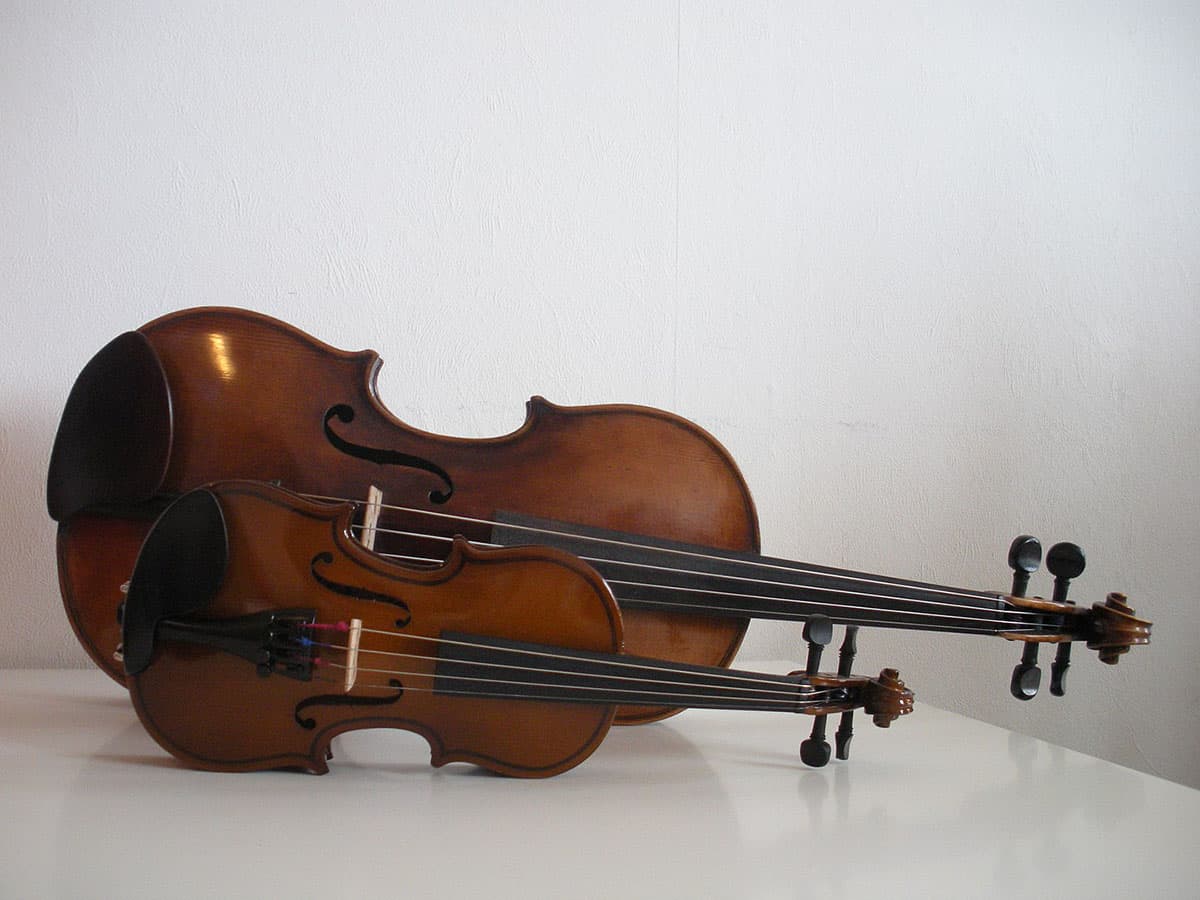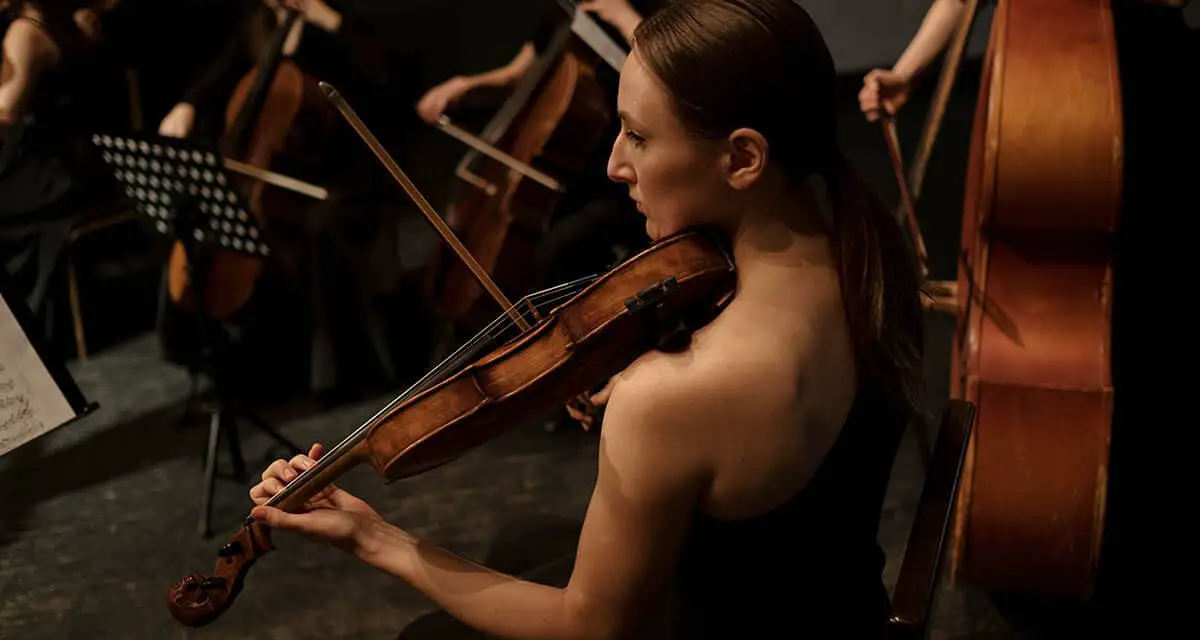The viola and the violin look almost identical to the untrained eye.
Both stringed instruments share the same color and shape and are played the same way so it can be hard to tell the difference.
In fact, there are a ton of similarities between these two instruments that belong to the same bowed string family:
- They share a similar shape
- They are both played with a bow
- They both have 4 strings
- They are both held on the shoulder when played
It may take a side-by-side comparison to realize one of the most noticeable differences between the two stringed instruments – the size.
The Viola is Larger in Size than the Violin
This is probably the most distinct difference between the violin and the viola.
The viola is a larger instrument that usually ranges between 16 – 16.5 inches and is typically about 1 – 4 inches larger than a violin.

Image and Source Attribution
A violin has a standard adult size of 23” – 23.5” in length (full 4/4) with another common size at 22.5” (7/8 size) in length depending on the player’s preference.
Of course, the sizes of each instrument can vary depending on the player’s age, size, and preference – but the takeaway here is that the viola is the larger instrument in the strings instrument family.
In fact, you can compare each of the strings instruments in the orchestra as follows from smallest to largest:
- Violin – smallest
- Viola – Medium
- Cello – Medium-Large
- Double Bass – Large (also known as the “stand-up bass” or “contrabass”)
Come to think of it… all four instruments in the strings orchestra family look similar in shape.
The size of the instruments can be associated with the range of sound each play – which is a major difference between viola vs. the violin.
Sounds and Tone: Viola vs. Violin
If you were to choose between one of these two incredible instruments, the sound and tone would be the first major consideration in your decision.
The violin is more commonly associated with prominent melodies as a solo instrument since it produces higher-pitched notes with a brighter-colored sound.
The viola, on the other hand, produces lower-pitched notes and has a warmer tone overall. It is more common in the orchestra and not seen as prominently as a solo instrument in popular live music styles like country, rock, and bluegrass.
Difference in Strings
Both the viola and the violin share a set of 4 strings and are tuned in fifths.
Note: Tuned in “fifths” means that the distance between one string and another string is the difference between the first note and fifth note in a major scale. If the first string is a G – the fifth note in the major scale would be D.
The violin, with the highest range of notes in the strings family, has its strings tuned G – D – A – E, with G being the lowest.
The viola has strings tuned as follows: C, G, D, and A with a lower range of musicality and thicker strings.
With this difference range – each instrument uses a different Clef when reading sheet music.
Difference in Bow
Seeing as the strings are thicker on the viola, they require a heavier bow to match them with a clear sound on the lower register.
The violin bow is thinner and more extended and weighs slightly less than the viola bow.
To an inexperienced player, they might look almost identical but to a stringed instrument musician, the difference is necessary. The viola bow is often curved on the end compared to the straight end of a violin bow which assists in bringing out the lower tone and playing with the size of the instrument.
Clef Difference: Viola vs. Violin
The violin – known as the soprano voice and the highest-pitched instrument in the string family uses the Treble Clef. This is a more common clef used in music by other instruments including the piano, trumpet, guitar, and oboe.
The viola uses the alto clef, also known as the “C clef”. In fact, other than the alto trombone, the viola is the only instrument that uses this unique clef.
What is more Difficult to Play: Viola or Violin?
It is hard to claim any one instrument is harder than another instrument. Depending on your skills and experience, you may find either one easier than the other.
With that said, the viola parts in an orchestra ensemble are often easier to follow than the violin counterparts since violin parts may have more prominent solos and melody lines.
That does not make the violin more difficult or the viola solos less challenging – it is just a consideration when evaluating each instrument and how they are played.
Some may consider a viola more challenging for a beginner musician simply due to the larger size, heavier weight, and thicker strings – making it require a bit more hand strength to play.
It could be considered that the violin might be more challenging on a musical level while the viola could be more physically challenging. Just like any other instrument, each one will have differences that may lend to your strengths depending on your current skills and experience.
Viola vs. Violin: Which Instrument is Right for You?
Perhaps you are reading this to help you decide between the two instruments and which one you should try first.
We recommend (with just about any musical journey) trying both options to see what feels best in your hands and what you might enjoy more.
Otherwise, there are some key considerations that might help persuade your decision from one instrument to the next.
- The violin is more suited for those who like playing solos and melodies that are clear and prominent in sound with high-pitched notes and fast musical ideas. The viola is more suited for players that want to bring out a more mellow tone – with something slower and darker than the violin.
- The violin is a great choice for those looking to play melodies in popular musical styles outside of the orchestra ensemble. With the bright and loud nature of the instrument, it is a great and common addition to pop, country, rock, bluegrass, and jazz.
- The viola could be a great choice for those looking for less competition as it is a more unique and uncommon instrument found among musicians. It is a great choice for those looking to bring a major addition to the orchestra without looking for attention with big melodies and solos.
No matter what, the choice of violin vs. the viola will come down to personal preference as there is no right or wrong answer to which instrument will be a better pick for you.








